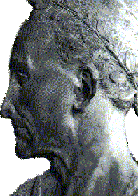|
|
|
PLATE H: (Below right) Image of C. Julius Caesar.

In 56 B.C. the political alliance at Rome between Caius Julius Caesar, Gnaeus Pompeius Magnus and Marcus Licinius Crassus had been renewed at the Italian town of Luca, ensuring the primacy of the three in Roman political life for the next few years. Caesar had his command in Gaul renewed when Pompeius and Crassus became consuls the following year, and by the end of that year Gaul had been largely pacified, despite a rising by the Usipetes and Tencteri tribes, which delayed Caesar's reconnaisance to Britain; Caesar looked for new opportunities for glory here.
Caesar sent his lieutenant Gaius Volensus ahead to reconnoitre for a suitable landing place while he gathered two of his legions and some auxiliary troops. Caesar landed somewhere in the region of Deal, the harbour held againt him by a force of Britons. The Romans were eventually able to make a successful landing and rout the Britons, but were unable to press their victory because contrary winds had prevented the Roman cavalry from making the crossing from Gaul.
Caesar now demanded hostages from the Britons that sued for peace. Meanwhile, by the fourth day, the cavalry transports had been wrecked by a storm and the transports Caesar had with him were badly damaged, leaving the Roman troops with little by the way of food. It was now that the Britons chose to slip away and renew their alliances against Caesar, and attacked the VIIth legion while it was foraging for food. Caesar, at the head of the Xth legion, just managed to rout the enemy force, but again could not follow up his advantage with cavalry. Twice as many hostages were demanded, and Caesar now took them back to Gaul with him.
During the next few months, Caesar gathered a force of six hundred transports and twenty eight warships, with five legions and two thousand cavalry. Eventually, around eight hundred vessels set out for a second season in Britain, including the privateers that accompanied them. There were preliminary skirmishes on a river then at a hillfort, ending in Roman victories. More bad weather damaged the Roman vessels, though not on the scale of the previous year. The vessels were beached and a fortified camp built around them.
Cassivelaunus, leader of the Catuvellauni tribe, was by now the war leader of the British forces, but another encounter between the Britons and three whole legions did not go well for the natives. The next major encounter was on the River Thames, fordable at only one (unknown) location. This Roman victory forced Cassivelaunus to adopt guerilla tactics, keeping only a small force of four thousand charioteers, which harried Caesar's line of march into the Catuvellaunian homeland. It was now that Caesar chose to re-install Mandubracius, a Trinovantian prince who was probably exiled due to Catuvellaunian influence. With a potentially hostile force at his back, Cassivelaunus was forced to sue for peace. Caesar, trough the Gaulish Atrebatan noble, Commius, demanded further hostages, tribute and guarantees that the Catuvellauni would not attack the Trinovantes again. The deal probably included provisions for trade with the Romans.